
The Chesapeake Bay Bridge, officially named the William Preston Lane Jr Memorial Bridge, crosses the Chesapeake Bay near Annapolis, MD. Officially opened as one span with 2-way traffic in 1952, it replaced two ferries that connected the metro areas of Washington DC and Baltimore to Maryland’s Eastern Shore. A parallel northern span was opened in 1973 adding 3 more lanes. When the bridge was built it was the world’s longest continuous over-water steel structure at 4.35 miles long. It has more than 400 steel & concrete pilings and over 2 miles of rip-rap lined access roads creating an exceptional habitat for striped bass. Read More!
 There is nothing quite like catching a big striper on top-water. I’ll never forget my first top-water explosion. I was twelve years old, walking the muddy banks of the Holston River in Eastern Tennessee with my father. The lure tied onto my fiberglass rod and Mitchell 300 reel was a wooden Chugger Spook. In my over-sized rubber boots, I was having a hard time keeping up.
There is nothing quite like catching a big striper on top-water. I’ll never forget my first top-water explosion. I was twelve years old, walking the muddy banks of the Holston River in Eastern Tennessee with my father. The lure tied onto my fiberglass rod and Mitchell 300 reel was a wooden Chugger Spook. In my over-sized rubber boots, I was having a hard time keeping up.
“Check your drag,” Dad commanded from his vantage point just below a large set of shoals. “Now, cast right into the “V” where the water runs through and start jerking.” As instructed, I reared back and slung my rod as hard as I could. I overshot the target and landed my lure upstream of the shoal. “Just let her drift down and pop it along,” he said.
Nothing in my limited experience of bank-side pan fishing could’ve prepared me for what happened next. The swift current pulled the chugger quickly down the rip and I popped it a few times along the way. Suddenly, the water blew up as if someone had thrown a hand grenade. A jolt of adrenalin shot though my arms as I felt the line tighten and heard the drag scream. Read More!
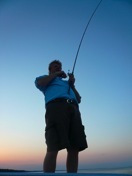
You don’t need expensive equipment to catch striped bass, you just need the right equipment.
One of the most frequently asked questions I hear from fishermen who want to get into the light tackle striper game is, “How do I know what kind of rod to buy.” It’s a simple question, but my usual answer is, “It depends.”
One of the biggest mistakes a beginning angler can make is spending hundreds of unnecessary dollars on overly advanced equipment. A G-Loomis rod with a Stella reel may make you look good as you’re walking down the dock, but it won’t put fish in the boat if it isn’t designed for the way you intend to fish. I fished for thirty-five years before I ever spent more than a hundred dollars on a rod. Did it improve my fishing? Yes, but in very small increments over a long period of time.
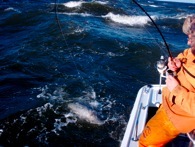 The wrong kind of rod can make it much more difficult to catch fish and lengthen the learning curve for catching striped bass. Before you buy an expensive rod you should know exactly what you want for the kind of fishing you plan to do. This is best learned by trial and error with less expensive, mid-level equipment. The phrase “you get what you pay for” is applicable, but there are some very respectable rods in the forty to sixty dollar range. I would never suggest a very cheap rod for anyone who is seriously considering light tackle striper fishing.
The wrong kind of rod can make it much more difficult to catch fish and lengthen the learning curve for catching striped bass. Before you buy an expensive rod you should know exactly what you want for the kind of fishing you plan to do. This is best learned by trial and error with less expensive, mid-level equipment. The phrase “you get what you pay for” is applicable, but there are some very respectable rods in the forty to sixty dollar range. I would never suggest a very cheap rod for anyone who is seriously considering light tackle striper fishing.
Although it probably seems like there are unlimited choices, there are basically three variables to consider when selecting a rod. They are length, action (also called speed or taper), and power. Each aspect is important when applied to specific techniques and can make a big difference in your fishing success.
Length
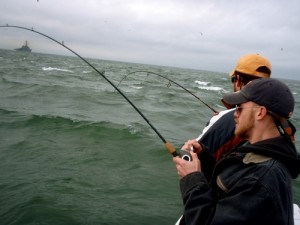 Other than surf and fly rods, the most common rod lengths used for light tackle striper applications are between six and seven feet. The longer the rod, the farther you can cast. A short rod gives you more strength and maneuverability. Shorter rods usually have less action making it easier to muscle the fish to the boat, while a longer rod will provide more play and can add to the action of your lures. Many good fishermen feel a shorter rod is more sensitive because there is less distance for the strike to travel before it is transmitted to the hands. My favorite rods incorporate the best of both worlds and are six foot six inches to six foot eight inches long.
Other than surf and fly rods, the most common rod lengths used for light tackle striper applications are between six and seven feet. The longer the rod, the farther you can cast. A short rod gives you more strength and maneuverability. Shorter rods usually have less action making it easier to muscle the fish to the boat, while a longer rod will provide more play and can add to the action of your lures. Many good fishermen feel a shorter rod is more sensitive because there is less distance for the strike to travel before it is transmitted to the hands. My favorite rods incorporate the best of both worlds and are six foot six inches to six foot eight inches long.
The length of the handle or butt is another important aspect. This is the part of the rod between the reel and the very back end of the rod. Spinning rods usually have longer butts than casting rods, but many fishermen who use baitcasters now prefer long handles. A longer butt can increase leverage and lengthen casts. It’s also helpful when you’re fighting a big fish because you can brace the butt against your chest or stomach for added leverage. I have recently been lobbying some rod makers to put longer butts on their casting rods for light tackle salt-water applications.
Action (speed or taper)
The action or speed of a rod refers to the taper of the graphite or fiberglass. The degree of taper is directly related to flexibility and how much the rod bends. It’s referred to in terms of speed because it’s how fast the rod snaps back when bent. Stiffer rods snap back faster than limber ones. Rod manufacturers define action in 4 categories: slow, medium, fast, and extra fast. Sometimes you hear taper referred to as “back-bone.” A rod that is stiffer with less flex down near the reel is said to have more back-bone.
Slow action means the rod will bend from one end to the other. They are usually hard to cast and make setting the hook difficult, but they can be useful for adding action to lures. The only time I use slow action is on an ultra light rod for perch or panfish. I do not know of a practical use for slow action rods in striper fishing.
On the other hand, I very frequently use a rod with medium action. Medium action rods are normally fairly rigid on the butt end, but taper quickly so there is a lot of wobble in the tip. This is my go-to rod for top-water fishing. A medium action rod used in association with a walk-the-dog lure is absolutely deadly for surface feeding rockfish.
Fast action rods are more useful for jigging. They’re also strong in the butt but still provide some flexibility at the tip, just not as much as medium rods. Most off-the-rack rods in the tackle shops have some degree of fast action - in my opinion, the faster the better.
Rod action classifications vary with manufacturers, so it’s best to try before you buy. My favorite rods for jigging have extra-fast action. You wont find many inexpensive rods with this kind of taper. Depending on the manufacturer there may be some flexibility at the rod tip, but there isn’t much. These are usually the most sensitive rods because they require high-grade materials to achieve the extra-fast snap. If I can find a six-foot to six-foot-eight inch rod with true extra-fast action, I know I have a winner.
Power
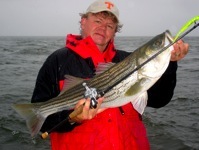 The power of the rod refers directly to the weight of the lure or line you plan to use, and the weight of the fish you hope to catch. Power ranges from ultra-light to ultra-heavy and there are multiple combinations in-between. Power is usually categorized by lure & line weight and is listed on the shank of the rod. While some manufacturers will not warranty a rod that is used with line or lures outside the specifications, the better ones will. I look at power specs as nothing more than a gauge to tell me the thickness and strength of the rod.
The power of the rod refers directly to the weight of the lure or line you plan to use, and the weight of the fish you hope to catch. Power ranges from ultra-light to ultra-heavy and there are multiple combinations in-between. Power is usually categorized by lure & line weight and is listed on the shank of the rod. While some manufacturers will not warranty a rod that is used with line or lures outside the specifications, the better ones will. I look at power specs as nothing more than a gauge to tell me the thickness and strength of the rod.
Power is very much a personal choice. Some anglers use heavier rods for stripers because they feel it’s important to get them to the boat quickly. To me, a rod that is too heavy defeats the purpose of light tackle fishing. I use medium or medium heavy rods exclusively and it’s never taken me more than a few minutes to land a striper. I recently landed a forty-five pounder in less than three minutes with a medium power rod using ten-pound-test line.
Simply put, lighter rods are more sensitive to strikes. Fishermen sometimes worry that a lighter rod might break with a big fish. This is rare. I’ve never snapped a quality rod on a fish. Sometimes rods get damaged in other ways, and the injury becomes apparent when fighting a fish.
All rods will break. Maybe it’s possible to design one that won’t, but I’m not sure I’d want to fish with it. Sometimes rods are broken by poor technique. The right method for fighting a big fish is to set the hook then point the rod directly at the fish. This allows the reel’s drag to take over and takes stress off the rod.
A word about line guides
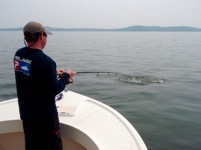 Line guides are frequently overlooked but they are also important when selecting a rod. First of all the guides should be lined up straight. This should be the first thing you check when you take a rod down off the rack. Sight down the rod to make sure none of the guides are out of synch with the others. The exception is specialty rods that intentionally spiral the guides.
Line guides are frequently overlooked but they are also important when selecting a rod. First of all the guides should be lined up straight. This should be the first thing you check when you take a rod down off the rack. Sight down the rod to make sure none of the guides are out of synch with the others. The exception is specialty rods that intentionally spiral the guides.
High quality lightweight guides can add sensitivity to a rod. Guides are usually either double-foot or single foot depending on how they are attached to the rod. On the lower end, most are stainless steel with a ceramic center. The quality of the ceramic can vary greatly from rod to rod. Generally, guides with harder ceramics are more expensive.
Many high-end rods have “Fuji” guides. These guides have been carefully researched and are made of very good materials ranging from high-polished ceramics to aluminum oxide to even pure gold. Poorly made guides will rust quickly or become grooved when using braided lines. Never use guides made of plain steel for saltwater applications. They will just rust and cut your line.
I prefer that the tip guide on my rods be made of rust-proof metal instead off ceramic. I frequently find myself reeling my leader knots though the tip, or sometimes even pulling a metal lure up tight to the guide. Eliminating ceramic from the tip keeps me from getting line-cutting cracks and breaks in the guide.
Design
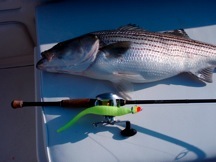 Fishermen will banter for hours about the virtues of a casting rod over a spinning rod or vice versa. It can be a “chicken or the egg” argument. I prefer a casting rod because that’s what I’ve always used, but I’ve fished with many good fishermen who use spinning outfits.
Fishermen will banter for hours about the virtues of a casting rod over a spinning rod or vice versa. It can be a “chicken or the egg” argument. I prefer a casting rod because that’s what I’ve always used, but I’ve fished with many good fishermen who use spinning outfits.
For beginners to intermediate fishermen, I suggest a spinning rod. The learning curve is not nearly so steep. Baitcasters offer an advantage when bottom jigging waters with rapidly changing depths, and take less energy to cast. But, spinning outfits can be better suited for suspended fish and are easier to use.
One thing I insist upon in a jigging rod is that the rod blank be cut out or exposed beneath the reel seat. An exposed blank allows my fingers to always be in contact with the rod, not the reel or the cork handle. I also prefer as little cork as possible anywhere on the rod. This includes the area immediately in front of the reel and farther back on the handle. This is not so important with a top-water outfit but when jigging, why in the world would anyone want to insulate the handle?
Materials
When I first started fishing, all my rods were fiberglass. My dad once let me use one of his custom rods made of wrapped leather. It was surprisingly sensitive. Most rods these days are made of graphite composites. Don’t stress out over the different designations manufacturers give graphite rods. Terms such as IM6, IM7, Modulus, etc. don’t mean a thing when comparing rods made by different manufacturers. There is currently no industry standard when defining the materials that go into a rod. Even the term “graphite” is subjective. The best rods are composites made from layers of true carbon graphite and other materials. The better rod builders closely guard the secret ingredients that make up their rods.
Custom Rods
There are some custom rod makers that turn out excellent rods. Some are absolutely beautiful with intricate designs and personalized detail. The advantage of a custom rod is that it can be designed to your exact specifications. I wouldn’t discourage anyone from investing in a quality custom made rod, but remember, just because a rod is “custom made” doesn’t mean it’s high quality. Materials can vary greatly between rod makers and you usually get what you pay for. Some custom rod makers use very cheap handles, guides, and other materials, while others use nothing but the best stuff on the market. As with all fishing equipment, let the buyer beware. Check things out carefully and talk to people you respect before investing hundreds of dollars in any rod.
If you’re considering an investment in a custom rod, I think it’s wise to experiment with off-the-rack rods for a while so you know exactly how you want one built. You’ll also want to talk to the rod builder to make sure they understand exactly how you fish and what you are looking for.
I have some custom rods that I dearly love, but I don’t always use custom rods mostly out of respect to the rod builders. I’m hard on rods. Real hard. I frequently break tips, wear out guides, handles, etc. I don’t mind sending an abused rod back to a national chain or major manufacturer, but after a year or two, I feel like I’m taking advantage of a struggling independent rod builder when I keep asking him to repair a lifetime warranty rod.
Freshwater vs Saltwater
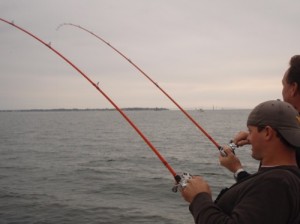 At the core of the concept of light tackle fishing is the use of rods designed for large and smallmouth bass for stripers. Unfortunately, very few manufacturers design rods for our kind of fishing. The industry hasn’t caught up with the fact that we use lighter equipment for bigger fish in the open waters of the Bay than we do in the heavy cover of freshwater lakes and rivers. Rods classified as “inshore” are usually way too heavy for stripers.
At the core of the concept of light tackle fishing is the use of rods designed for large and smallmouth bass for stripers. Unfortunately, very few manufacturers design rods for our kind of fishing. The industry hasn’t caught up with the fact that we use lighter equipment for bigger fish in the open waters of the Bay than we do in the heavy cover of freshwater lakes and rivers. Rods classified as “inshore” are usually way too heavy for stripers.
The biggest problem light tackle Chesapeake Bay fishermen encounter is durability. The components on a freshwater rod rust, break, or wear out quickly when they’re constantly exposed to harsh saltwater conditions. Before buying a rod, check the warranty carefully and hold on to your receipts. You will need them.
My choices
Over time, you will develop your own personal rod preference that fits your individual fishing style. If you frequently change the type of rod you use you will always find yourself making mental adjustments because of the varying sensitivities. I think it’s best to settle on one style and stick with it.
The only time I consider a rod with more than one section is for traveling. One-piece rods are more sensitive because the flow of energy though the graphite is uninterrupted. My light tackle method consists of three primary one-piece rod types. All the rods I use for striped bass fishing are variations on these three styles.
For casting top-water plugs I use a six-foot six-inch or seven-foot medium action rod with medium heavy power. This rod gives me enough leverage for long casts and is stiff enough at the butt to handle big fish. It provides lots of flex in the mid-section and tip so I can really get it moving and put lots of action in the lure.
For jigging lightly weighted jigs up to one ounce I use a six-foot to six-foot six-inch fast action, medium power rod. This rod is light enough so that I can feel the jig well, but not so heavy that it wears me out casting it. The fast tip provides plenty of sensitivity.
For jigging one to two ounce jigs, I use a six-foot six-inch to six-foot-eight inch medium power rod with extra fast action. These are my most frequently used rods in the Chesapeake Bay. They’re also my most expensive and most sensitive rods.
I don’t usually put a lot of emphasis on casting distance when selecting jigging rods. It’s rare that I ever have the need to cast over fifty yards when I’m using jigs. Most of my casts are short wrist flips targeted toward where I think the fish might be.
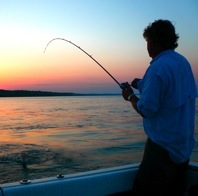 There are rare instances when I might use seven-foot or longer rods. This is usually in situations when I need to cast spoons, top-water plugs, or slashbaits for long distances. A good example is spring on the Susquehanna Flats.
There are rare instances when I might use seven-foot or longer rods. This is usually in situations when I need to cast spoons, top-water plugs, or slashbaits for long distances. A good example is spring on the Susquehanna Flats.
I insist that all my rods weigh as little as possible. Even my heavier rods weigh less than five ounces. Because of the importance I put on weight, I don’t like a lot of added lacquer or other bells and whistles. Lighter rods paired with high-quality lightweight reels make casting less strenuous, provide added sensitivity, and reduce fatigue. I was recently fishing with a very good angler who asked how I kept from getting tired after hours of non-stop jigging using two-ounce heads. I handed him my outfit and his mouth dropped open before he said, “Two of your rods don’t weigh as much as one of mine!”
Good luck picking out the perfect rod! Remember, start with relatively inexpensive equipment until you refine your techniques and know exactly what you like. One you’ve figured out your favorites, stay with them.
 White shad are an anadromous species that spend the vast majority of their life at sea, but enter the Chesapeake region in the spring to spawn. They are highly sought-after for both their flesh and their roe. It is delicious. White shad are also an important species in American history. The Native Americans fished for them extensively and used the left-overs to fertilize their crops. George Washington was known as a prolific white shad angler and caught thousands near his home on the Potomac River. It was the spring shad run in Pennsylvania’s Schuylkill River that saved Washington’s army from starvation at Valley Forge. Read More!
White shad are an anadromous species that spend the vast majority of their life at sea, but enter the Chesapeake region in the spring to spawn. They are highly sought-after for both their flesh and their roe. It is delicious. White shad are also an important species in American history. The Native Americans fished for them extensively and used the left-overs to fertilize their crops. George Washington was known as a prolific white shad angler and caught thousands near his home on the Potomac River. It was the spring shad run in Pennsylvania’s Schuylkill River that saved Washington’s army from starvation at Valley Forge. Read More!
 Fall is here and so is hot action beneath the birds on the Chesapeake Bay. Nothing gets a fisherman’s blood boiling like spotting hundreds of frenzied gulls on the horizon. Certain to be underneath is a voracious school of hungry rockfish and bluefish. There’s nothing more frustrating however than throwing everything in the tackle box at them only to pull in a few little fish.
Fall is here and so is hot action beneath the birds on the Chesapeake Bay. Nothing gets a fisherman’s blood boiling like spotting hundreds of frenzied gulls on the horizon. Certain to be underneath is a voracious school of hungry rockfish and bluefish. There’s nothing more frustrating however than throwing everything in the tackle box at them only to pull in a few little fish.
Here’s a top-water tandem that I refined in schools of breaking white bass back on the Tennessee lakes. It was shown to me first by my father and I’ve modified it somewhat for the more toothy critters in the Chesapeake. Read More!
 When the weather starts to warm, most Chesapeake Bay anglers have stored their umbrella rigs and stacked up their broomstick-sized tolling rods. The spring migration is long over and dreams of landing a trophy rockfish have faded. But don’t hang up those high hopes yet. There are still some nice fish around for anglers who are willing to downsize their gear and adjust their techniques.
When the weather starts to warm, most Chesapeake Bay anglers have stored their umbrella rigs and stacked up their broomstick-sized tolling rods. The spring migration is long over and dreams of landing a trophy rockfish have faded. But don’t hang up those high hopes yet. There are still some nice fish around for anglers who are willing to downsize their gear and adjust their techniques.
After forty plus years of freshwater fishing on TVA lakes in the Southeast, I moved to Maryland last year with visions of catching big rockfish. Through years of fishing for landlocked stripers in the lakes of the Tennessee River system, I had refined my techniques and felt relatively confident in my fishing ability. Nevertheless, I was a complete novice on saltwater and knew nothing about fishing techniques for the Chesapeake Bay. Read More!


